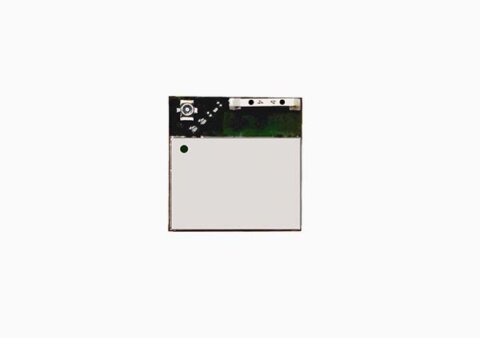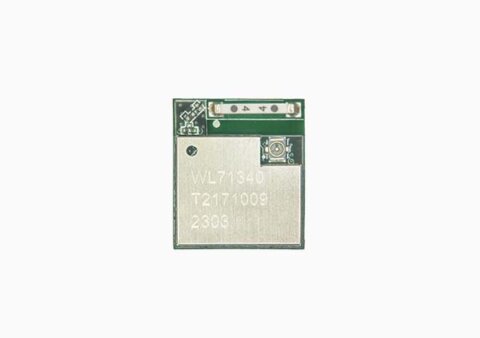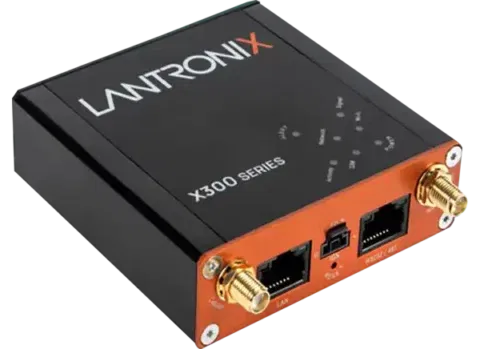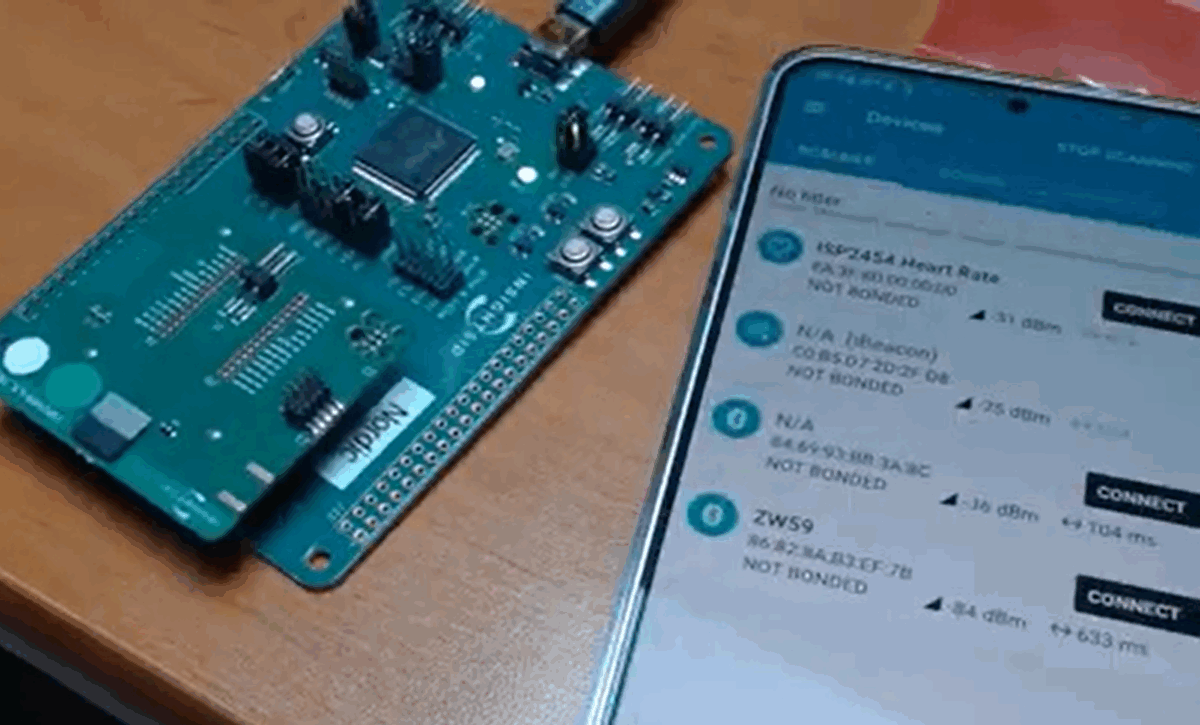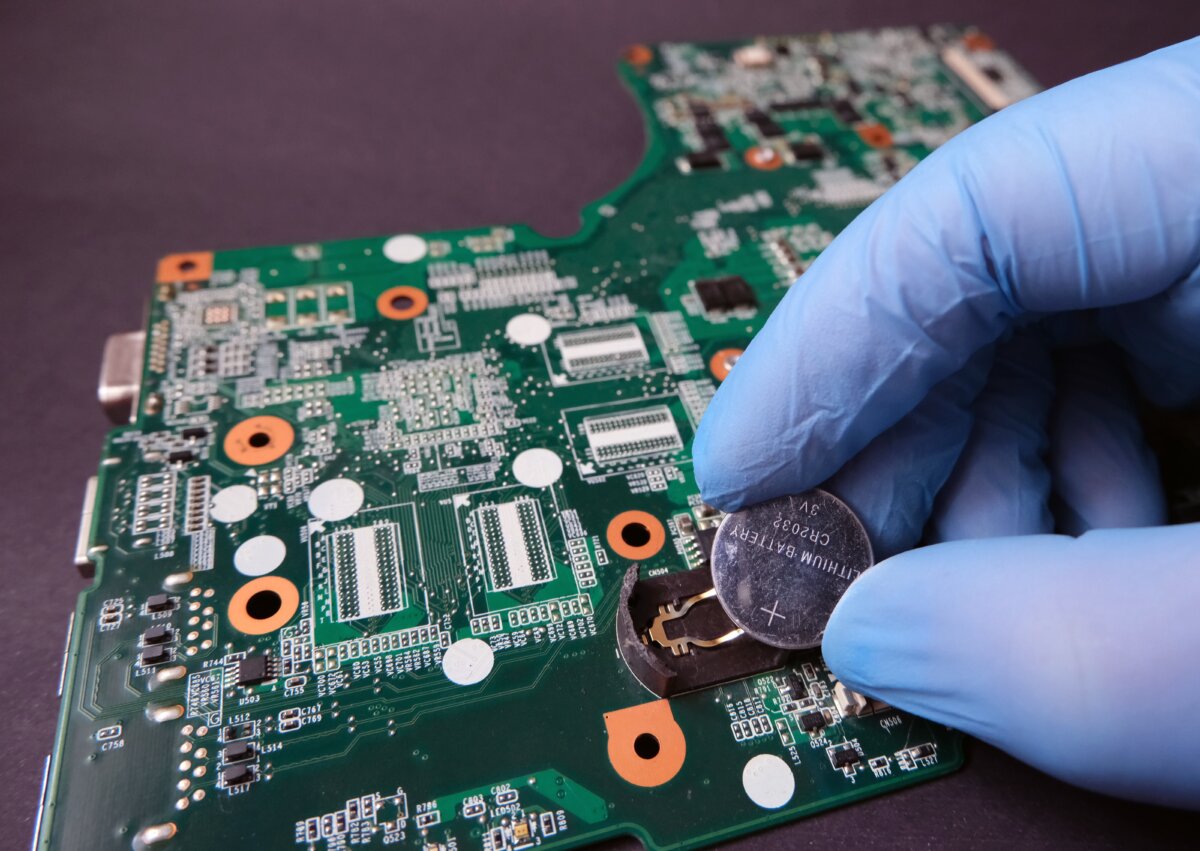Bluetooth Low Energy (BLE) for Industrial IoT
Technical guide
This in-depth guide explores how Bluetooth Low Energy (BLE) technology is transforming industrial and embedded systems. Discover how BLE enables energy-efficient, secure, and scalable wireless connectivity across applications like predictive maintenance, medical wearables, and asset tracking. Packed with technical insights, integration tips, and real-world examples, this article helps design engineers and system developers make informed decisions when implementing BLE in their next project.
Table of contents
- Introduction to Bluetooth Low Energy (BLE)
- Technical foundations of BLE
- Key features and specifications
- BLE hardware and integration
- BLE product selection
- Industrial use cases and applications
- Strategic considerations for businesses
- Reliability and security of ble
- Industrial and process integration
- Research and technological developments
- Conclusion
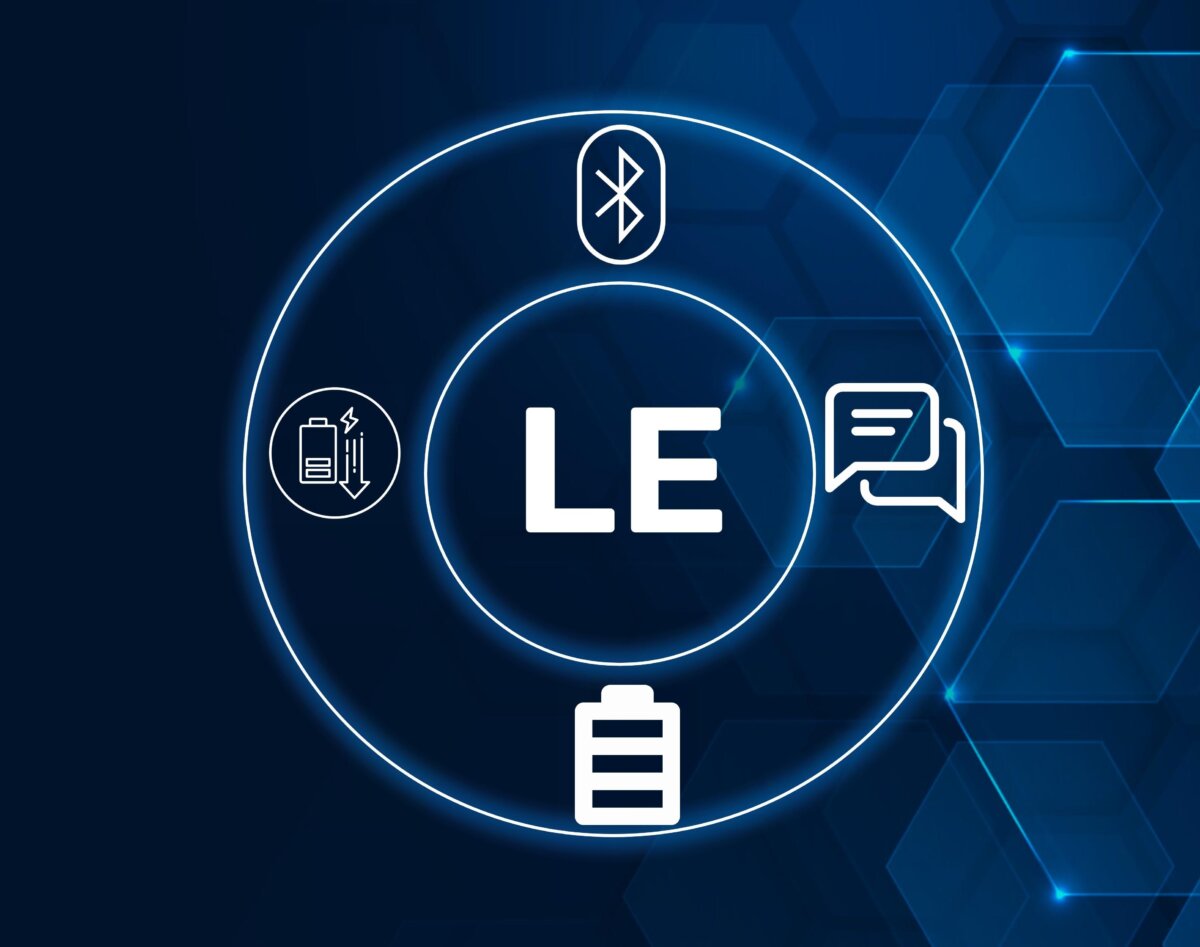
Introduction to Bluetooth Low Energy (BLE)
What is BLE and why is it important?
Bluetooth Low Energy (BLE) is basically the streamlined, power-conscious version of Bluetooth. It rolled out with Bluetooth 4.0, but it’s been getting steady updates – right up to 6.0 now. Designed for scenarios where battery life is precious and devices can no longer afford to be power hungry, such as embedded systems, wearables, medical devices, home entertainment – any application where reliable wireless communication is needed without draining the battery.
How did BLE evolve from Bluetooth Classic?
The technical difference from Bluetooth Classic is huge. Classic Bluetooth is built for high-throughput, continuous data – think wireless headphones streaming music. BLE, on the other hand, is optimised for short, intermittent bursts of data. Devices send out small advertising packets and only establish full connections when absolutely necessary. This design lets BLE devices sit idle or sleep most of the time, so they can run for years off a coin cell battery.
Why use BLE over other wireless protocols?
Why pick BLE over Zigbee or Wi-Fi? For one, BLE has ultra-low power requirements. It’s also baked into basically every smartphone and modern OS, so integration is straightforward – no need for extra hardware. BLE is cost-effective for low-data-rate applications, and it balances throughput, range, and reliability pretty well. While Zigbee works best for sprawling mesh networks and Wi-Fi is the go-to for bandwidth-heavy needs, BLE nails it for compact, battery-powered devices that need efficient, short-range communication.
In short: BLE is the go-to for engineers building connected devices that need to be small, efficient, and easily paired with mobile hardware.
Speak to our IoT & Wireless experts about your BLE design challenges:
BLE vs. Bluetooth Classic and other protocols
| Technology | Data Rate | Power Consumption | Typical Range | Use Case Focus |
|---|---|---|---|---|
Bluetooth Classic | Up to 3 Mbps | Moderate (mA range) | 10–100 meters | Audio streaming, file transfer |
Bluetooth Low Energy | Up to 2 Mbps (5.0+) | Ultra-low (µA sleep range) | 10–100 meters | Sensors, wearables, IoT |
Zigbee | Up to 250 kbps | Low | 10–100 meters | Mesh networks, home automation |
Wi-Fi | Multi-hundred Mbps | High | Up to 100 meters | High throughput data, internet access |
Technical foundations of BLE
Bluetooth Low Energy (BLE) architecture is a layered protocol stack, meticulously engineered for minimal power consumption and efficient radio utilisation.
What are the core layers of BLE?
The stack splits into two primary blocks: the Controller (handling the PHY and Link Layer functions) and the Host (responsible for upper layer protocols), interconnected via the Host Controller Interface (HCI).
The key layers include:
-
Physical Layer (PHY): Operates in the 2.4 GHz ISM band, utilising Gaussian Frequency-Shift Keying (GFSK) modulation. Standard throughput is 1 Mbps, with later specifications supporting 125 kbps (LE Coded PHY for extended range) and 2 Mbps (LE 2M PHY for higher performance).
-
Link Layer: Governs packet organisation, device advertising, scanning, and connection management. It tightly integrates with the PHY to optimise radio wake times and ensure low power operation, while also establishing secure links.
-
GAP (Generic Access Profile): Manages device visibility, advertising modes, connection establishment, and role assignment. Also oversees basic security processes relevant to device access.
-
L2CAP (Logical Link Control and Adaptation Protocol): Responsible for multiplexing data from higher layers, segmenting and reassembling packets, and providing logical channels for communication between devices.
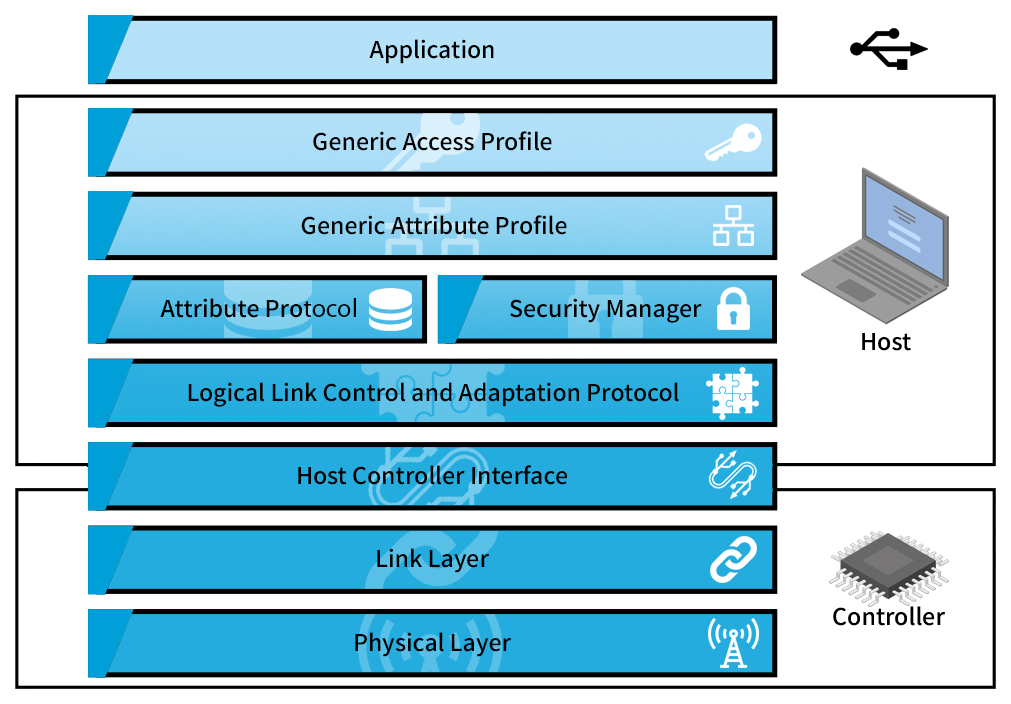
-
ATT (Attribute Protocol): Defines a client-server framework for data access, supporting operations such as read, write, notification, and indication of attribute values.
-
GATT (Generic Attribute Profile): Structures ATT data into hierarchical services and characteristics, each identified by standardised or custom UUIDs, facilitating interoperability between devices.
-
Security Manager Protocol (SMP): Handles cryptographic pairing, bonding, and key distribution to enforce link-level security.
Each layer fulfills a distinct function, collectively enabling BLE devices to communicate efficiently, securely, and with exceptionally low energy consumption.
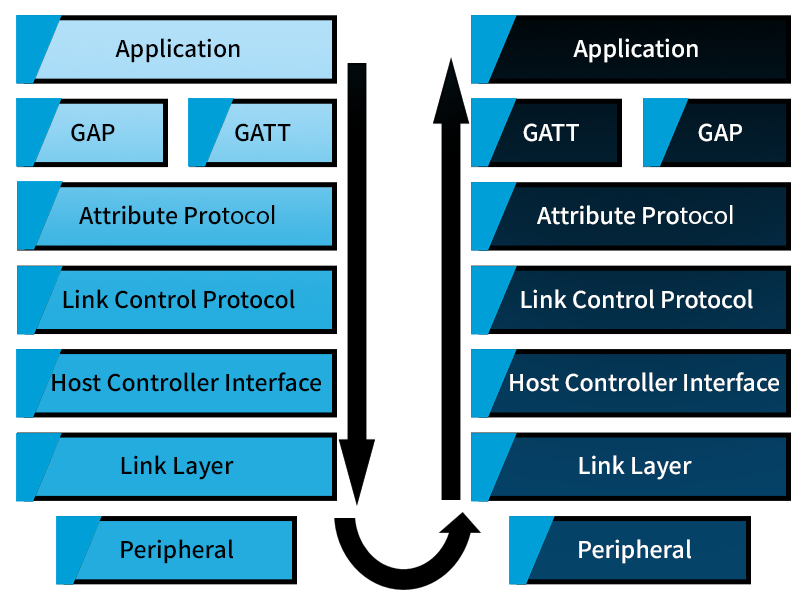
BLE operating roles: Central vs. peripheral, advertising and connection process
Bluetooth Low Energy (BLE) is engineered for efficient, low-power wireless communication over short distances. Under the hood, you’ve got a layered protocol stack – GAP handles connections, GATT and ATT structure the data, and L2CAP deals with juggling logical channels. All of this is basically there to keep connections flexible, secure, and reliable.
How do BLE devices communicate?
when it comes to device roles, BLE splits things up like this:
- Peripheral: These are low-power nodes – think sensors or beacons. They’re not out there scanning the world; instead, they broadcast their presence by sending out compact advertising packets (31 bytes each, nothing huge) at regular intervals. It’s a “Here I am, connect if you want” approach.
Peripherals start things off by advertising at set intervals, which can range from a speedy 20 milliseconds up to several seconds, depending on how aggressive or battery-conscious they need to be.
- Central: This is your typical smartphone, hub, or gateway. Centrals are more active – they scan the airwaves, pick up on those advertising packets from peripherals, and, if they spot something interesting, initiate a connection. They can even juggle multiple peripheral connections at once.
Central devices are scanning for these signals and, once they find a peripheral, they send a connection request. Once linked, both devices exchange data during scheduled connection events – that’s when packets go back and forth, optimising for both power savings and low latency.
In summary: peripherals advertise, centrals scan and connect, and after that, data flows in timed bursts to keep performance up and energy consumption down. That’s BLE connectivity in a nutshell.
How does BLE compare to Bluetooth Classic and other protocols?
BLE, or Bluetooth Low Energy, is designed for ultra-low power consumption and energy harvesting technologies. It uses shorter data packets, a streamlined protocol stack, and keeps radio activity to a minimum, which means devices – think sensors, wearables, medical monitors – can operate for years on coin cell batteries. Bluetooth Classic , by contrast, maintains continuous, high-throughput connections. It’s optimised for applications like wireless audio, where you need a steady data stream, but it burns through power much faster. Zigbee? That protocol has its place in Bluetooth mesh networking, but BLE wins hands-down for integration with smartphones and PCs, plus it’s simpler to commission for IoT and embedded deployments.
| Feature | Bluetooth Classic | Bluetooth Low Energy (BLE) |
|---|---|---|
Frequency Band | 2.4 GHz ISM Band | 2.4 GHz ISM Band |
Number of Channels | 79 one MHz channels | 40 two MHz channels |
Power Consumption | Low | Less |
Data Rate | 1–3 Mbps | 1 Mbps |
Latency | Approx. 100 ms | Approx. 6 ms |
Range | < 30 m | 50 m (150 m in open area) |
Topology | Peer-to-peer (1:1) | Peer-to-peer (1:1), Star (many:1), Broadcast (1:many), Mesh (many:many) |
Device Pairing | Required | Not Required |
Voice Capable | Yes | No |
Nodes / Active Slaves | 7 | Unlimited |
Security | 64b/128b bit, user-defined application layer | 128-bit AES, user-defined application layer |
Smartphone Compatibility | 100% available on smartphones | 100% available on smartphones |
Use Cases | Audio streaming, file transfer, headsets | Location beacons, smart home apps, medical devices, industrial monitoring, fitness trackers |
What’s new in Bluetooth 5.0 – 5.3?
Now, the recent Bluetooth 5.x specs (5.0 through 5.3) introduced a number of enhancements that expand BLE’s range, speed, and efficiency:
-
LE Coded PHY: Extends transmission range significantly (up to around 300 meters outdoors), thanks to forward error correction and configurable coding rates (500 kbps or 125 kbps). This boosts signal reliability in challenging environments.
-
2M PHY: Doubles BLE’s maximum data rate to 2 Mbps, so devices can transmit more quickly and return to sleep mode sooner – directly improving battery life.
-
Periodic advertising: Enables devices to send synchronised broadcast packets at set intervals, optimising beacon and asset tracking applications for lower energy use.
-
Directional finding (5.1+): Supports angle-of-arrival (AoA) and angle-of-departure (AoD) measurements, enabling precise spatial location features.
-
Enhanced ATT (EATT) (5.2): Allows multiple parallel GATT transactions, which boosts data throughput and responsiveness, especially in multi-device scenarios.
-
LE power control: Devices can dynamically adjust transmit power, optimising link quality while minimising energy consumption and radio interference.
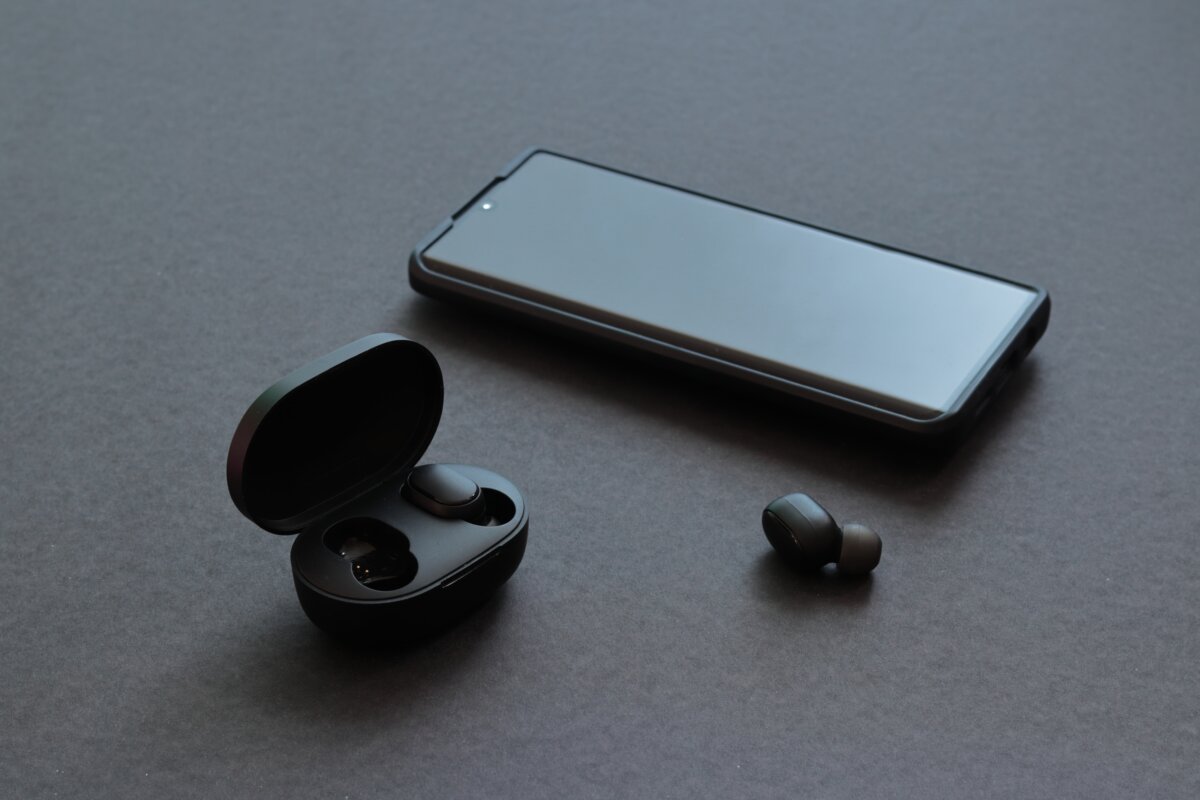
These updates make low power Bluetooth BLE even more versatile for industrial IoT, wearables, and embedded systems, enhancing range, speed, and power efficiency. Put simply, these advancements make BLE more robust, increasing range, throughput, and efficiency. It’s now a top choice for industrial IoT, wearables, and embedded systems—anywhere you need reliable wireless with ultra-low power or energy harvesting demands.
Discover how our IoT & Wireless Technology Centre can support your next project.
Key features and technical specifications of Bluetooth Low Energy (BLE)
Bluetooth Low Energy (BLE) is basically engineered for ultra-low power operation and energy harvesting – perfect for devices that need to run off tiny batteries for months, even years. You see BLE everywhere: fitness trackers, medical sensors, smart home gadgets, and all kinds of IoT things. It operates in the 2.4 GHz ISM band, but it’s optimised for efficiency, not brute-force speed or range.
Ultra-low-power operation
Low power BLE spends most of its time in a deep sleep, only waking up for short bursts to send or receive data:
- Current draw: Is super low – just microamps when idle, peaking under 15 mA during activity.
- Power consumption: Power consumption sits around 0.01 to 0.5 watts, which is far less than classic Bluetooth’s 1W ballpark.
- Battery life: Many BLE modules can operate for months or even years on a single coin-cell battery.
- Wake latency: Wake-up time is fast – about 6 ms to jump from sleep to active state. Compare that to classic Bluetooth’s sluggish 100 ms wakeup, and you get why BLE is such a battery-saver.

Typical range and data rates
On the radio side, low power Bluetooth BLE uses 40 channels, 2 MHz each, with Gaussian Frequency Shift Keying (GFSK) modulation.
Standard data rate is 1 Mbps (LE 1M PHY), but there’s also a 2 Mbps mode for higher throughput if you’re willing to sacrifice range. If you need more distance, Bluetooth 5 introduced the LE Coded PHY (125 or 500 kbps), which can reach hundreds of meters in good conditions. Typical indoor range sits around 50 meters; outdoors, you might hit 150 meters, or up to 240 meters with the right hardware and Bluetooth 5.

Secure connections, pairing, bonding, and AES-128 encryption
Security is a big deal for BLE, especially in healthcare and smart home contexts. Bluetooth Low Energy (BLE) employs robust security mechanisms to protect data and connections.
- Uses AES-128 encryption in CCM mode to protect communications.
- Pairing options: include Just Works, Passkey, Numeric Comparison, and Out-of-Band, depending on how much security and convenience you need.
- Bonding: Once paired and bonded, devices store security keys for seamless reconnection.
- LE Secure Connections: With Bluetooth 4.2 and up, LE Secure Connections uses Elliptic Curve Diffie-Hellman (ECDH) for even stronger protection against eavesdropping and MITM attacks.
BLE is all about minimal energy consumption, fast wake-up, flexible data rates and range, and robust security-making it the go-to for modern low-power wireless applications.
GATT services and UUIDs: Structure and customisation for industry-specific applications
GATT and UUIDs in BLE provide a structured, modular framework for organising data exchange between devices. Within GATT, data is segmented into profiles, services, characteristics, and descriptors – each uniquely identified using a UUID (Universally Unique Identifier).
Standard UUIDs: The Bluetooth SIG defines a set of 16-bit or 32-bit UUIDs to enable interoperability across manufacturers. For example, the Heart Rate Service uses 0x180D, while the Heart Rate Measurement characteristic uses 0x2A37
Custom UUIDs: When industry-specific requirements arise, developers leverage 128-bit custom UUIDs, allowing tailored data structures without sacrificing compliance with the GATT specification. This balance of standardisation and customisation is critical for industrial and IoT deployments.
BLE mesh networking: structure, relay nodes, scalability in industrial environments
Bluetooth Mesh networking extends BLE’s capabilities well beyond the traditional star topology.
Bluetooth Mesh enables many-to-many device communication, allowing messages to propagate through multiple nodes. Relay nodes forward messages, dramatically increasing network coverage. Friend nodes and Low Power Nodes (LPNs) optimise energy consumption; friend nodes buffer messages until LPNs wake and retrieve data. Proxy nodes connect mesh devices to legacy BLE devices or phones. The architecture supports thousands of nodes and employs self-healing, redundant communication paths to ensure reliability, even in large-scale or mission-critical environments.
These design choices make BLE Mesh networking suitable for advanced industrial applications, including facility-wide smart lighting, asset tracking, environmental monitoring, and predictive maintenance. In summary, the combined flexibility of GATT (with customisable UUIDs) and the scalability of Bluetooth Mesh deliver a robust solution for modern industrial IoT needs.
BLE hardware and module integration
Bluetooth Low Energy (BLE) integration is all about combining low-power radio tech with ready-to-go modules. You’ll find solutions from vendors like Raytac , built-in antennas, modules supporting external antennas and sometimes even energy harvesting features for battery-free applications. These modules are used everywhere – wearables, industrial sensors, medical devices, you name it.
Which hardware options are available?
For integration, a few things need your attention:
- Antenna Design: Integrated antennas make life easier, especially for certification. If you go with a custom PCB, stick to the vendor’s reference layouts. Pay close attention to ground clearance, impedance matching, and antenna placement to get solid range.
- PCB Layout: Keep the BLE module isolated from noisy circuits. Avoid running traces beneath the antenna, and make sure you’ve got proper decoupling and filtering close to the BLE radio to keep things running smoothly.
- Power Supply: Go for low-noise, low-dropout regulators. Make sure your design can handle the peak current during BLE transmit cycles. If you’re using energy harvesting, your power storage and management needs to be up to the job.

What are the key integration challenges?
Antenna tuning and placement (it’s tricky), managing interference on your PCB, and keeping your power supply rock solid.

What about certification?
Certification is a must for anything Bluetooth. Every device needs to go through Bluetooth SIG qualification. Pre-certified modules make this a lot simpler – just use the module’s Declaration ID when you apply for FCC, CE, and similar approvals. Saves a lot of time and hassle.

How can engineers get started?
To get started, contact us for a dev kit or eval board. You’ll get integrated modules, debugging tools, SDKs, and plenty of sample code for typical BLE applications. We offer you extra support – layout reviews, firmware help – that will get you to market faster.
Today’s BLE modules let engineers add secure, low-power wireless to their designs with far less RF expertise than before. Pre-certified hardware and solid vendor support mean you get reliable, compliant products to market without reinventing the wheel every time.
Get design-in support from our wireless engineers Find out more
BLE modules for scalable IoT and industrial connectivity
Industrial use cases and applications of BLE
Where’s BLE being put to work these days?
Strategic Considerations of Bluetooth Low Energy (BLE)
Financially, BLE modules are extremely efficient – think bill of materials (BOM) under $5 each when you’re manufacturing at scale.
That’s a no-brainer for industrial rollouts where every penny matters. Power-wise, they’re engineered for ultra-low consumption. A typical sensor or beacon can run for years – literally, one to five on a simple coin cell. That means fewer battery swaps, less downtime, and lower labour costs. Some modules even monitor their own battery health, so you get proactive alerts and can schedule maintenance before stuff fails. That’s operational efficiency right there.
How does BLE simplify operations?
On the operations side, BLE’s connection model is designed for simplicity. Devices advertise and scan, forming connections quickly without needing complex infrastructure. You can use star or mesh topologies, often skipping the need for extra hubs – especially in small to medium deployments. BLE can broadcast data for things like asset tracking or beacon services without requiring full-blown connections, which is a huge plus. For long-term support, you get secure over-the-air firmware updates and standardised provisioning, making device management much less of a headache.
What’s the organisational impact?
From an organisational perspective, BLE lets you retrofit existing products with wireless connectivity. That’s a fast track to IoT features – remote monitoring, mobile app integration, predictive maintenance – without a total redesign. Development is faster thanks to mature SDKs and a well-supported ecosystem. And because BLE is standardised globally, your solutions will work with most industrial and consumer tech out there. One thing, though: rolling out BLE at scale isn’t plug-and-play. You’ll need expertise in hardware, firmware, RF design, and certification. Partners like Acal BFi can handle the nitty-gritty -consulting, module sourcing, PCB/antenna design, and guiding you through Bluetooth SIG and regulatory certifications. Which means your team can focus on deployment, rather than troubleshooting.
How does BLE compete in the market?
BLE, or Bluetooth Low Energy, carves out a competitive niche against Zigbee, Wi-Fi, and UWB, largely due to its remarkable power efficiency and native compatibility with smartphones. It supports both star and Bluetooth Mesh topologies, making it adaptable for various networking needs. While the maximum data rate caps at 2 Mbps, that’s actually sufficient for a huge chunk of IoT devices. The extended range (100+ meters, thanks to LE Coded PHY) means BLE can cover large industrial spaces or smart homes without breaking a sweat. Security-wise, AES-128 encryption is baked right in, so data transmissions aren’t left exposed.
Comparison of Wireless Technologies Competing with BLE
| Feature | BLE | Zigbee | Wi-Fi | UWB |
|---|---|---|---|---|
Power Consumption | Ultra-low (µA sleep, mA tx) | Low (higher than BLE) | High | Moderate to high |
Data Rate | Up to 2 Mbps | Up to 250 kbps | Mbps to Gbps | Hundreds of Mbps |
Topology | Star, Mesh (Bluetooth Mesh) | Mesh | Star | Point-to-point |
Mobile Integration | Native | Limited (requires hubs) | Native | Limited |
Range | Up to 100+ meters | 10–100 meters | 50–100 meters | Short, high precision |
Security | AES-128, Secure Pairing | AES-128 | WPA2/WPA3 | Limited encryption |
Applications | IoT, wearables, beacons | Home automation, monitoring | High-bandwidth data | Positioning, secure access |
Acal BFi streamlines Bluetooth BLE adoption with a full-stack approach – consulting, hardware sourcing, prototyping, and navigating certification. This cuts down on development headaches and time-to-market, ensuring robust, energy-efficient wireless solutions that can actually compete in today’s crowded market. In short, BLE’s flexibility and strong ecosystem make it a solid option, especially when power consumption and interoperability are top priorities.
Explore how Acal BFi can support your next BLE project by contacting our IoT & Wireless experts today.
Reliability, security and industrial compliance for Bluetooth Low Energy (BLE)
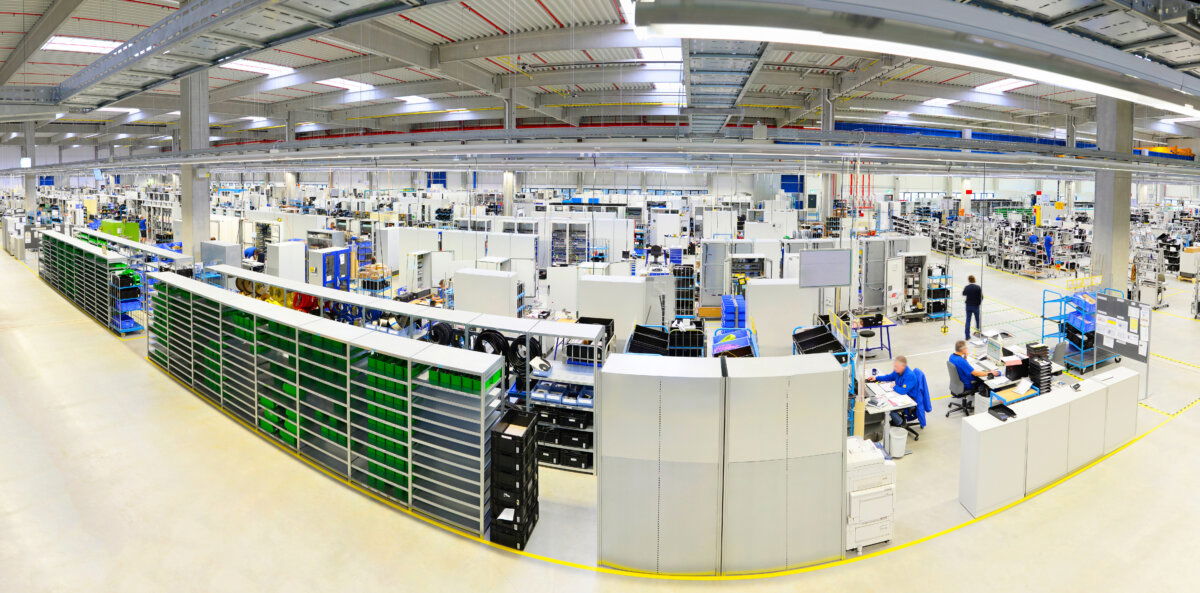
Is BLE reliable in harsh RF conditions?
Yes – BLE’s actually designed for exactly that kind of chaos – think factory floors with a mess of Wi-Fi, Zigbee, and all sorts of electromagnetic interference. Here’s how BLE keeps connections steady:
-
Adaptive frequency hopping (AFH): BLE slices up the 2.4 GHz band into 40 channels, then hops between them super fast to dodge any crowded or noisy spots.
-
Dynamic transmission power: Radios don’t just blast at max – they adjust output to the lowest level that still keeps the link solid, which helps cut down on interference and keeps the signal reliable.
-
High receiver sensitivity and antenna design: Industrial BLE modules use sharp receivers and smart antenna layouts so signals stay strong, even with obstacles or interference.
-
Extended range with LE Coded PHY (Bluetooth 5.x): Forward error correction (S=2 or S=8) lets BLE reach way farther- indoors, you’ll get 10 – 40 meters, and outdoors, well over 100 meters line-of-sight isn’t crazy.
All these features – especially the frequency hopping – give BLE a robust link budget. That’s exactly why it works for things like predictive maintenance, condition monitoring, and real-time location tracking (RTLS), where you can’t afford dropouts.
How secure is it against threats?
From a security standpoint, low power Bluetooth BLE has got multiple layers to keep data locked down:
-
AES-128 encryption: Everything sent over BLE is encrypted, so eavesdroppers are out of luck.
-
Secure pairing methods: Options like passkey entry, numeric comparison, and out-of-band keep man-in-the-middle attacks at bay during setup.
-
MAC address randomisation: Makes it hard for anyone to passively track devices, but trusted devices can still recognise each other through identity keys.
-
Device invisibility modes: Devices can stay hidden and only show up when pairing, which minimises the attack surface.
BLE’s security stack is up to the task—solid enough for industrial and medical use, where data privacy and integrity really matter by safeguarding sensitive data.
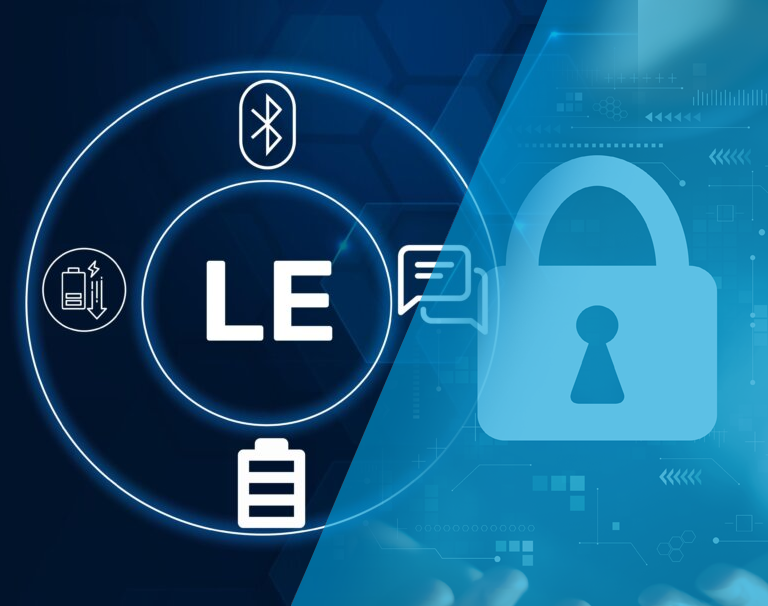

Is BLE compliant for industrial and medical use?
With the right setup, BLE satisfies technical compliance demands across medical, industrial, and enterprise sectors.
-
Medical: BLE supports HIPAA compliance by using AES-128 encryption and secure pairing protocols to protect patient data.
-
Industrial: BLE is capable of aligning with IEC 62443 requirements—think secure device authentication, data integrity checks, and safe over-the-air (OTA) updates. In terms of privacy regulations like GDPR, BLE enables address randomisation and leverages secure communication protocols to minimise data leakage risks. Industrial-grade BLE modules also undergo Bluetooth SIG qualification, plus meet FCC, CE, and other international certifications for radio performance, electromagnetic compatibility, and safety.
-
Consumer & Enterprise: Supports GDPR and other privacy regulations through address randomisation and secure protocols.
Industrial and process integration for Bluetooth Low Energy (BLE)
What operational benefits does BLE bring? In short, it’s a solid enabler for wireless sensor networks and portable devices, and it checks a lot of boxes in terms of efficiency and practicality:
How can BLE integration be optimised?
If you want to optimise BLE integration, you need a methodical approach – there’s no winging it here. Here’s how you keep things on track:
Start with a vendor’s dev kit. Validate radio performance, firmware, and data flow right at the start. That way, you’re not scrambling to fix issues after you’ve committed to hardware. And don’t just test in a clean lab—get into real-world environments with Wi-Fi, Zigbee, and industrial noise to see how BLE holds up. Check that your hardware can take the heat (and cold) too.

Here’s the checklist:
-
Use pre-certified BLE modules or SoCs that play nice with your existing MCUs. It’ll save you a lot of integration time.
-
Stick to PCB best practices good antenna placement, solid ground planes, and solid RF isolation. Don’t let noisy circuits mess with your signal.
-
Set up dynamic power management and flexible connection intervals. You want to balance battery life, latency, and throughput based on your use case.
-
Prototype early with dev kits and validate everything before finalising the hardware.
-
Test in the real world with all the usual interference and temperature swings you’ll see on the job.
-
Enable secure and robust OTA updates Makes maintenance far easier and keeps your devices up to date.
-
Roll things out gradually. Start with small pilots, iron out any bugs or reliability issues, then go full scale.
-
Bring end users into your testing. If the workflow doesn’t fit, it’s better to catch that early rather than after deployment.
This sort of process doesn’t just reduce design risk – it gets you to market quicker and sets you up for scalable, reliable, and energy-efficient BLE deployments in tough industrial or embedded settings.
We can work with you to optimise and scale your BLE solution.
Research and technological developments for Bluetooth Low Energy (BLE)
What’s new in BLE research?
Bluetooth Low Energy (BLE) technology is rapidly advancing, with significant progress in mesh networking, audio features, and location-based services.
-
BLE Mesh networking is seeing widespread adoption in industrial automation, smart buildings, and city-scale IoT deployments. Its many-to-many, self-healing network topology connects thousands of nodes, supporting high scalability and robust communication. Current research is focused on optimising mesh protocols for lower latency, higher throughput, and improved power efficiency, especially in dense deployments.
-
Performance evaluations indicate BLE Mesh provides streamlined configuration and integrates well with smartphones, outperforming some legacy protocols in setup simplicity. However, interoperability with Wi-Fi and Zigbee networks continues to pose challenges. Researchers are investigating adaptive routing, retransmission techniques, and spectrum management strategies to enhance network reliability and coexistence.
-
Bluetooth 5.2+ and later versions introduce features like Bluetooth LE Audio, advanced direction finding (AoA/AoD), and enhanced proximity services. These innovations pave the way for new applications in hearing aids, multi-stream audio, asset tracking, indoor navigation, and industrial logistics.
What’s emerging in hardware?
In terms of hardware, advancements in chipset and system-on-chip (SoC) design are enabling more intelligent and energy-efficient BLE devices.
-
Ultra-low-power operation supported by ambient energy harvesting technologies such as solar, RF, and thermal sources – is reducing or even eliminating the need for batteries in some cases.
-
AI on the Edge: Emerging BLE chipsets also feature embedded machine learning accelerators, facilitating edge AI processing to minimise communication overhead, conserve energy, and reduce latency in sensor networks.
-
Multi-protocol SoCs: highly integrated multi-protocol SoCs are becoming standard; these chips support BLE alongside other wireless protocols such as Wi-Fi, Thread, Zigbee, and UWB, promoting flexible, multi-radio IoT solutions.
-
Security-first designs Security is now a design priority, with hardware-based cryptography and secure key storage becoming standard to counter evolving cyber threats.
What challenges remain?
Despite advances, engineers must address key deployment considerations:
-
2.4 GHz interference: BLE operates in the same 2.4 GHz spectrum as Wi-Fi and Zigbee, so it’s highly prone to interference – especially in dense environments. Sure, adaptive frequency hopping, dynamic power management, and time-slicing can reduce the impact, but there’s still no silver bullet. Research into advanced coexistence protocols is very much ongoing.
-
Bandwidth and range trade-offs: BLE maxes out at 2 Mbps and, under ideal conditions with LE Coded PHY, maybe hits around 100 meters. Not exactly impressive for high-throughput or long-range needs. Engineers often employ mesh networks, multi-hop relays, or blend BLE with Wi-Fi or LoRa to address coverage and reliability gaps.
-
Power management for sensing: Continuous sensing eats battery life – no way around it. Event-driven or passive sensing helps, but there’s always a trade-off between data granularity and battery longevity. Optimising sampling rates, aggregating data, and fine-tuning duty cycles is critical for balancing performance and energy efficiency.
The Bluetooth Core Specification is evolving – higher data rates, improved coexistence, Bluetooth LE Audio, enhanced direction finding, and streamlined provisioning are all in the pipeline or already rolling out. With smart system architecture and careful design decisions, engineers can work around BLE’s inherent constraints and build scalable, robust networks for industrial, consumer, and IoT deployments.
Future prospects and industry impact
What’s BLE’s long-term role?
Bluetooth Low Energy (BLE) isn’t going anywhere – expect it to be a backbone for IoT infrastructure well into the next decade. Its ultra-low power requirements, solid interoperability, and cost-effectiveness make it the go-to for everything from smart wearables to industrial automation. Analysts expect BLE’s market to rocket from $12 billion in 2025 to over $39 billion by 2035. It’s not just consumer devices either – think smart factories, automotive, healthcare, and more.
Pretty much every mobile device comes with native BLE support, so integration headaches aren’t really a thing. That’s a huge plus for deployment and future-proofing. Plus, BLE’s capability to support massive sensor networks makes it the default choice for scalable IoT – both in the consumer space and on the enterprise side. How will multi-protocol solutions shape the future?
Multi-protocol is the new flavour. BLE’s teaming up with Thread and Wi-Fi, making flexible, hybrid networks a reality. Multi-protocol SoCs are a thing – BLE, Zigbee, Thread, even proprietary 802.15.4 – running together on the same silicon. So, developers aren’t stuck picking a single protocol. Thread meshes combine with BLE’s direct device connections and smartphone compatibility, making for secure, scalable IoT networks. Wi-Fi + BLE? That’s your go-to for device provisioning, OTA updates, and local proximity features – BLE handles the low-power link, Wi-Fi does the heavy lifting for data. And let’s not forget Matter: it’s built to operate across BLE, Thread, and Wi-Fi, locking in BLE’s spot in any cross-ecosystem setup.
Which industries will adopt next?
Healthcare is leading the charge. BLE powers wearables, patient monitoring, and asset tracking, with adoption rates soaring past 30% year-on-year. Expect mainstream use across hospitals by the late 2020s, thanks to HIPAA-compliant, pre-certified modules. Aerospace is moving slower – strict RF and safety standards mean the initial focus is non-critical stuff like maintenance sensors and diagnostics, with more critical adoption maybe by 2028–2035. Other regulated sectors (defence, heavy industry) are waiting for the security, certification, and interoperability frameworks to mature, but it’s coming.
With smart Bluetooth and multi-protocol integration, mesh networking, and broad ecosystem buy-in, low power Bluetooth / BLE is set to stay at the core of secure, efficient IoT networks across pretty much every vertical through the 2030s and probably way beyond.
Conclusion
Bluetooth Low Energy (BLE) has really carved out its place in the world of wireless connectivity – especially when you’re talking embedded or industrial setups. It’s not just about sipping power; it’s about being scalable, playing well in multi-protocol environments, and honestly, making engineers’ lives easier. Whether you’re rolling out sensor networks, streamlining infrastructure, or trying to get a bunch of different devices to actually talk to each other without a meltdown, BLE is the go-to.
You see it in industrial automation, asset tracking, smart infrastructure, healthcare, even aerospace. BLE’s reliability and cost-effectiveness are huge reasons for that. And now, with the rise of BLE Mesh, LE Audio, direction finding, and those multi-protocol SoCs, the use cases just keep multiplying – think Industry 4.0, smart cities, and other IoT applications where downtime is not an option.
Getting from idea to deployment isn’t always a smooth ride. That’s where Acal BFi can support you. Offering technical consulting, design support, and hardware solutions – you can go from prototyping BLE systems to full-scale deployment easily. It’s a solid way to make sure your wireless network actually delivers and remains within budget.
